Wondering how much your appliances really cost to run? Power Cost Electricity Meters are here to answer that.
These devices measure the energy consumption of your electrical appliances, translating it into actual costs.
This helps you understand which devices are energy hogs and where you can save on your electricity bill.
Through our thorough testing, we’ve identified the best Power Cost Electricity Meters for accuracy, ease of use, and comprehensive features.
Here are NerdTechy’s top picks:
- P3 International ‘Kill a Watt’ – The original, and arguably still the best, power usage monitor on the market. It’s exceptionally accurate, and provides a variety of measurements. That said, it doesn’t actually tell you the cost of your power. So if your concerns are economical rather than practical or environmental, you’ll still have math to do.
- kuman KW47 – A more modern appearance, and similar functions to the ‘Kill a Watt’. It also allows you to easily calculate your power costs. On the downside, the accuracy is only 3 percent, which isn’t good enough for commercial use. But for a homeowner trying to save energy, it should be fine.
- Poniie PN1500 – Similar to the ‘Kill a Watt’ in function, but not in accuracy. At 1 percent, it falls between the ‘Kill a Watt’ and the KW47. That said, it’s easy to use, and the display is very easy to read. We also appreciated the backlight, which comes in handy when reading in a darkened environment.
P3 International ‘Kill a Watt’
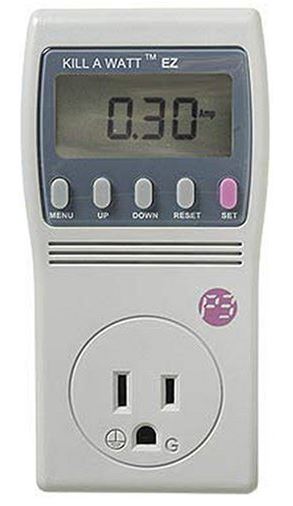
As we briefly mentioned, the P3 International ‘Kill a Watt’ is a very popular model. This is no accident. P3 was the first company to aggressively market their power use monitors.
They were also the first to talk publicly about phantom power and other related issues. To top it all off, they’re experts at all types of measuring technology. We’ve actually reviewed some of their hose flow meters, and liked what we saw.
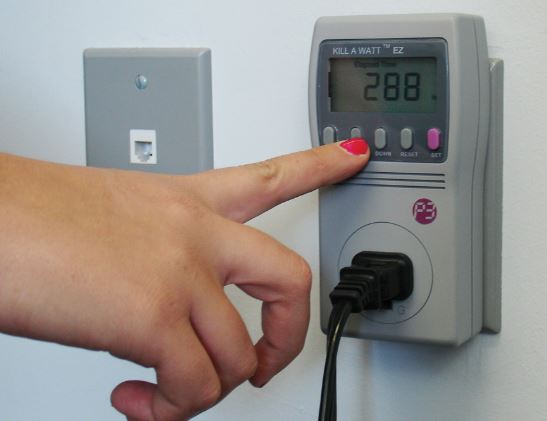
The Kill a Watt’s design will be familiar to anyone who’s ever watched late-night infomercials. It consists of a roughly rectangular block, which is slightly bowed at the top. The bottom half houses a three-prong power outlet, with an LCD display housed in the top portion.
The total height is about five inches, with a width of about 2 ½ inches and a thickness of just over an inch. Because of this design, you can insert the ‘Kill a Watt’ in the top half of a duplex outlet without blocking the bottom.
Admittedly, P3 hasn’t gone to any trouble to modernize the design or make it look more attractive. The housing is off-white and blocky, with an aesthetic straight out of the 90s. Even so, the basic concept is sound enough that pretty much every other power usage monitor has a similar layout.
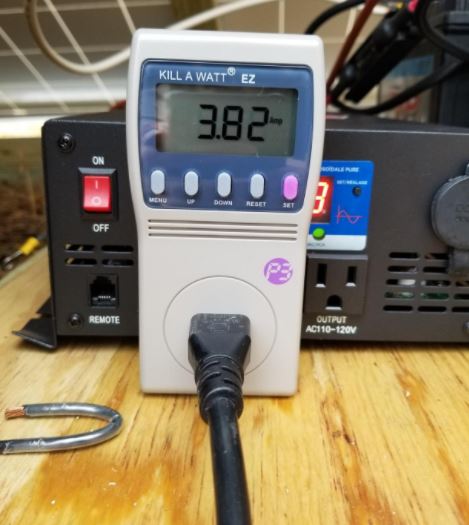
Beneath the LCD display and above the power outlet, you’ll see a row of five buttons. They’re mid-sized and rubbery, ideal for easy operation without removing the meter from your outlet.
The first three switch measurement units between volts, amps, and watts or volt-amps respectively. The fourth can be used to measure Hz or power frequency. The final button can be used to cumulatively measure hour of operation, or kilowatt-hours (kWh).
Performance and Accuracy
Using the ‘Kill a Watt’ is fairly straightforward. First, unplug the device you want to measure, and plug the ‘Kill a Watt’ into the outlet instead.
Now, plug your device into the outlet on the Kill a Watt’s housing, and watch the magic happen. What exactly you’ll see will depend on the settings. You can view the current power draw in volts, watts, or amps, which shows what your device is actually pulling.
The maximum power rating is 15 amps, or 1,875 watts. In theory, that’s more wattage than a 15-amp circuit is capable of providing. So for anything shy of a 20-amp circuit you’ll have plenty of capacity. Furthermore, you get the RMS voltage, which is a more accurate way of reading AC voltage.
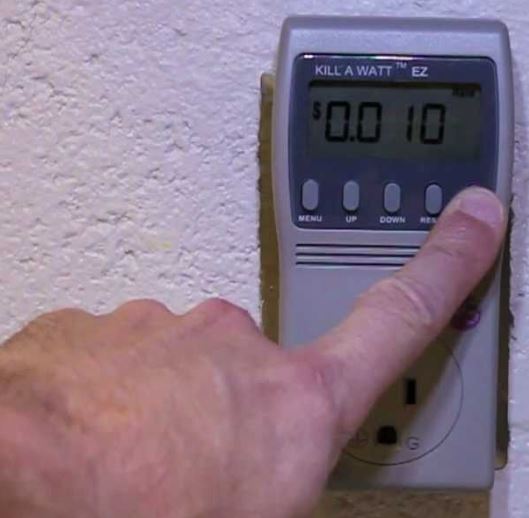
There’s one option in particular that bears closer scrutiny. This is the ability to switch between reading in watts and reading in volt-amps (VA).
As you may or may not remember, calculating watts is fairly straightforward: you just measure volts times amps. So a 120-volt device running at four amps is drawing 480 watts of power. But AC currents fluctuate, and multiple AC devices on the same current may or may not be in sync.
This means that circuits with multiple devices don’t scale linearly. For example, suppose you have a pair of 480-watt toasters on the same circuit. On a DC circuit, they would draw a total of 960 watts.
But on an AC circuit, they draw variable power, maxing out at 960 watts. VA is a more straightforward measurement, simply measuring the voltage times the amps, not the actual current drawn.
This makes it more reliable for AC systems. Those two, 480-watt toasters might not draw 480 watts at any given moment. But they’ll always have a total draw of 480 volt-amps.
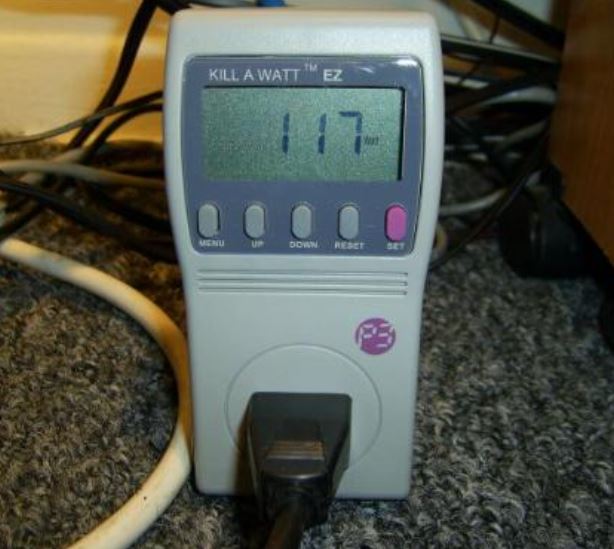
Using the last button in the line, you can measure power usage over a period of time. You can take averages by the day, week, month, or even year.
You can also get a simple total of the power drawn from the time you first plugged in the ‘Kill a Watt’. This makes it a versatile measuring tool, for a variety of applications.
As for accuracy, you’re looking at one of the best-performing electricity usage monitors on the market. It’s accurate to 0.2 percent, which is truly exceptional.
A measurement of 120 volts, for example, would be accurate to within 0.24 volts. A measurement of five watts would be accurate to 0.01 watts. Of course, we’d expect nothing less from the world’s premier monitor.
kuman KW47
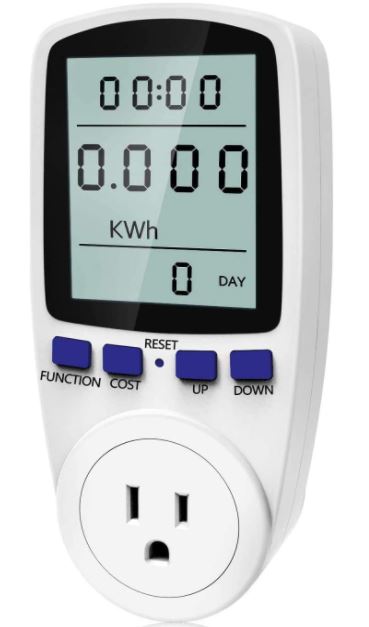
The kuman KW47 is a more modern electric monitor, with a more modern profile to match. The display is significantly larger, and includes elapsed time as well as your ordinary measurements.
There are only four buttons instead of the Kill a Watt’s five, but they’re positioned in the same general area. These are used to cycle through display modes, rather than selecting them directly.
The housing is white, rather than off white, and has a curvier form factor. But these are only superficial differences, for the most part.
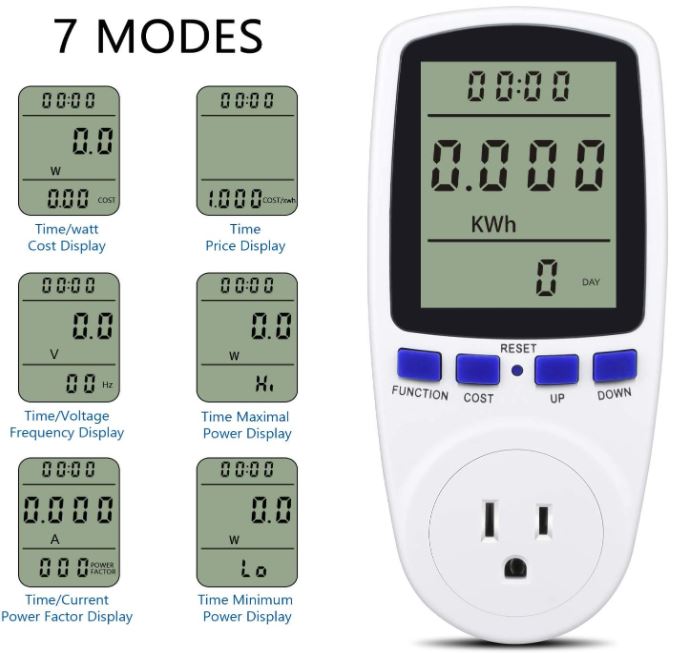
That said, the KW47 offers one significant feature that the ‘Kill a Watt’ doesn’t: the ability to track power cost. Here’s how it works. When you first plug the meter into your wall, it will ask you to enter your power costs per kWh.
This information can be found on your utility bill. If you just want a rough approximation, the default number is the national average. But if you’re going to go out of your way to buy a power cost meter, why not do things the right way?
By using your actual cost from your bill, you’ll get the most accurate measurements. Using this setting, it’s easy to tell how much a new device is going to cost you.
For example, if you bought a new PC, you could measure the cost for the first month. Then, you could play with your power management settings to see if next month is cheaper.
Performance and Accuracy
The KW47 can read and track watts, volts, amps, kWh, and power factor. Power factor is a measurement of efficiency, or the actual wattage versus the volt-amperage. The higher the power factor, the more efficient your devices.
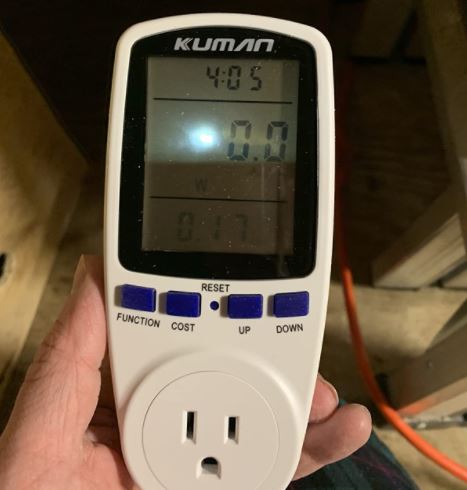
The one thing you can’t view that you can view on the ‘Kill a Watt’ is the power frequency. In theory, all US circuits should be operating at 60Hz, so you shouldn’t need this measurement.
However, measuring the frequency could be helpful if you’re diagnosing a faulty device or circuit. There’s also a backup battery inside, so the monitor will always remember your last settings.
The total maximum capacity is 15 amps and 1,650 watts. That’s nearly the maximum for a 15-amp circuit, and should be plenty for most home appliances.
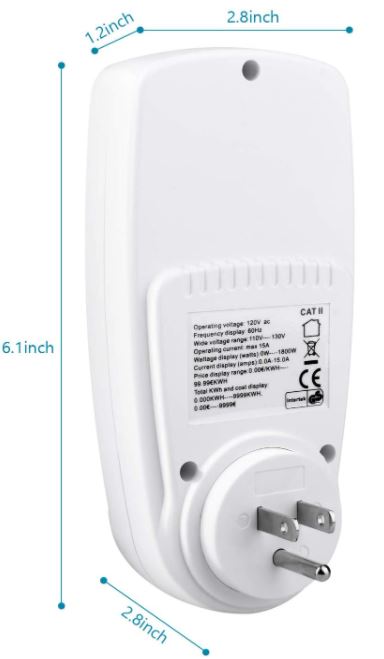
Power usage is measured in kWh every 24 hours. When a full day has passed after plugging in your device, the total power usage for that day will be displayed.
At that point, you’ll have two options. You can either view the last day’s average, or the current day’s average.
There’s even a timer telling you how much time has passed since the last reset. Because of this function, it makes sense to plug in the KW47 at a time you’ll be able to check it.
If your timer is always resetting while you’re at work, you won’t always have the most up-to-date information.
Unfortunately, the KW47 isn’t nearly as accurate as the ‘Kill a Watt’. Instead of an accuracy of 0.2 percent, you get an accuracy of up to 3 percent.
Your numbers will be more or less correct, but they’re not going to be pinpoint accurate or useful for scientific purposes.
Poniie PN1500
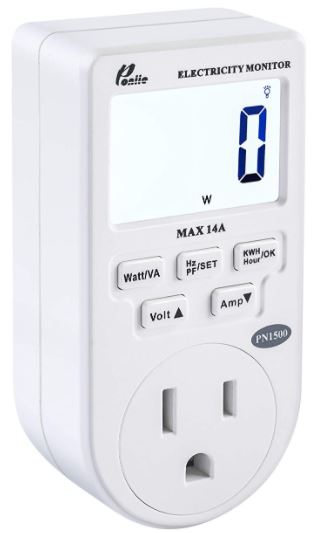
The Poniie PN1500 is somewhat of a cross between the ‘Kill a Watt’ and the KW47. It combines the Kill a Watt’s functionality with the KW47’s more modern profile.
The appearance is certainly contemporary, with a glossy white housing that blends into any modern room. And the five buttons are large and rectangular, so they’re easy to operate.
The most standout feature, though, is the large display. The numbers are tall and easy to read, with kWh displayed in larger digits and elapsed time in smaller ones.
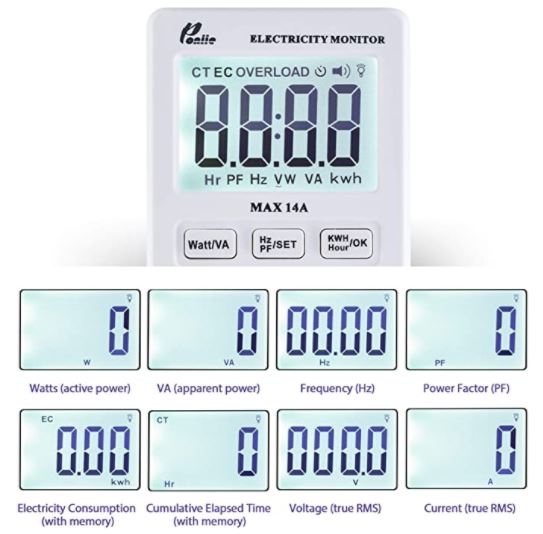
You can also cycle through other display options such as volts and watts.
This display is even easy to read behind a shelf or inside a cabinet. It has a bright backlight that’s activated with a single button.
This light can either be toggled on and off, or turn off automatically after 10 seconds depending on your settings.
Performance and Accuracy
The PN1500 has a maximum power rating of 14 amps and 1,500 watts. This allows it to monitor anything you should be plugging into a 15-amp outlet.
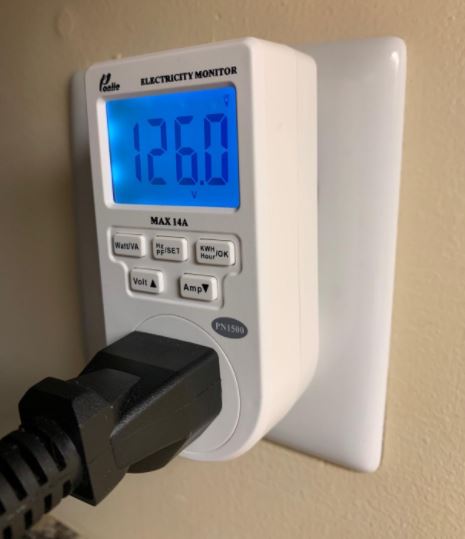
But there are edge cases. For instance, many space heaters draw a full 15 amps, so the PN1500 wouldn’t work for them.
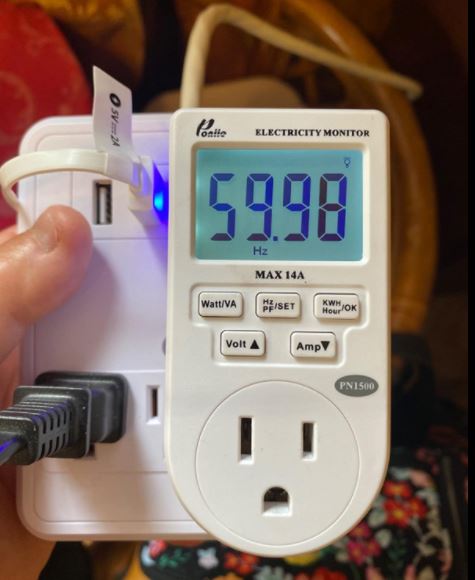
This monitor can measure all the same units as the ‘Kill a Watt’. One area where this monitor does fall shy is accuracy. It’s accurate to 1 percent, which is fine for around the house.
But if you need a truly accurate measurement for commercial purposes, you’ll want something more precise.
Meet Ry, “TechGuru,” a 36-year-old technology enthusiast with a deep passion for tech innovations. With extensive experience, he specializes in gaming hardware and software, and has expertise in gadgets, custom PCs, and audio.
Besides writing about tech and reviewing new products, he enjoys traveling, hiking, and photography. Committed to keeping up with the latest industry trends, he aims to guide readers in making informed tech decisions.

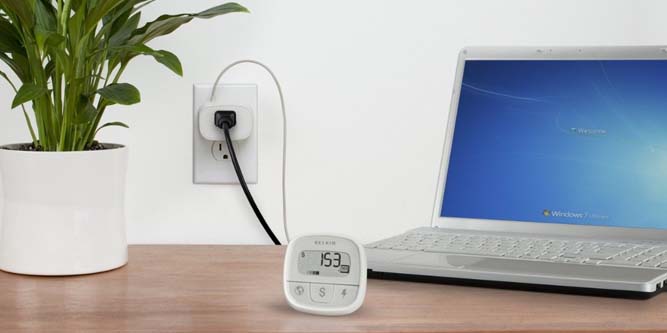
Hi, do you know of any waterproof/outdoor usage meters?
I am interested in finding how many hertz my portable generator is producing? What is the best device for that service? Thanks
Harry,
I assume you want to know if your generator can power some thing.
You first need to know what you want to power and how much power it needs, say in the event of home power failure you might want enough power to keep a few lights on and the fridge and maybe the TV. That’s one use for these meters, getting average power consumption of your appliances to budget a generator. I looked up these values but lets say fridge = 800w, lights = 300w, tv = 200w and an extra 300w for parasitic power draw.
1600w of 60hz AC 120v @ <= 15A
Your generator must deliver at least 1600w of electricity @ 15 amps, and some % more to prevent brown out. The generator should come rated for max power and max power @ 15amps.
You probably don't need to worry about amps or volts as most consumer electrical goods won't exceed 120v/15a which is what your generator likely delivers (OEM might call the plug 120v/20a, doesn't matter). If you're trying to power something you wouldn't plug into a wall at home you will need to consider these, some heavy appliances and machinery need 240v and/or 30a for example.
Hertz is not a unit of electricity, if you're American, you're likely to have a 60hz inverter in your generator. Continuous output in watts is the most useful metric for most generator purposes.
The meters here are all likely to measure power in / automatically detect 50 or 60hz depending on region. Hertz simply refers to the pulses per second for AC power (alternating current). In general Europe uses 50hz and USA uses 60hz. There is usually no reason to measure this as it should be obvious.
ICE, diesel, turbine, solar, etc.. generators produce DC power that they either dump into batteries (my company uses massive flywheels for their UPS) or directly to an inverter, a device that converts DC electricity to AC.
Now most electrical endpoints don't actually want to use AC and are designed to convert AC back to DC with built in power supplies that take AC and deliver an exact voltage, usually with a variable amperage. This is done because AC travels through wires more efficiently and is less dangerous if one is electrocuted.